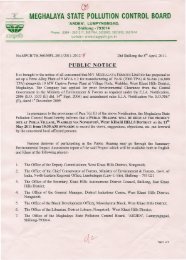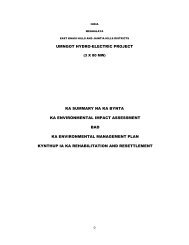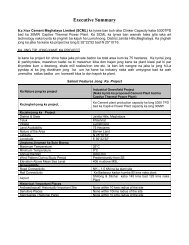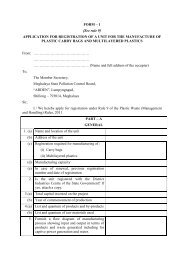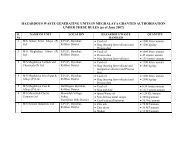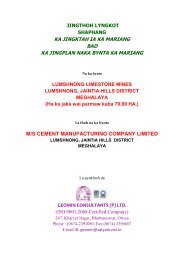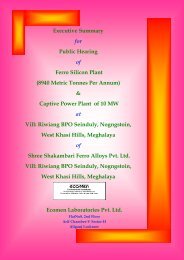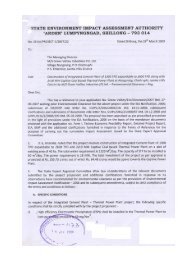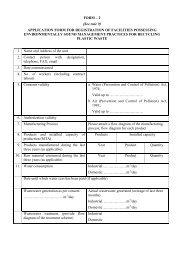Executive Summary - English - Meghalaya State Pollution Control ...
Executive Summary - English - Meghalaya State Pollution Control ...
Executive Summary - English - Meghalaya State Pollution Control ...
You also want an ePaper? Increase the reach of your titles
YUMPU automatically turns print PDFs into web optimized ePapers that Google loves.
PART - IENVIRONMENTAL IMPACT ASSESSMENT (EIA)I. INTRODUCTION1.1 The Government of India has established an exclusive Ministry of Environment and Forests (MOEF)for taking care of environmental protection needs. Safeguarding the interests of environment is done throughsuitable identification of Environmental Impacts and preparing suitable Environmental Management Planswhile sanctioning establishment of industries, reservoirs/dams, railways, thermal power plants, etc to mitigatethe impact. In other words, any project interfering with the environment is governed by the EnvironmentalProtection Act enacted by the Government of India. The Ministry of Environment and Forests (MOEF),Government of India, therefore, is the nodal agency for sanctioning the Environmental Clearance fordevelopmental projects. While clearing the projects, the MOEF is taking care of the environmental needswithin and around the areas of different developmental projects/schemes in the Country.1.2 As part of the process for the mandatory Environmental Clearance as notified, and as per the Termsof References provided, by the MOEF, Govt. of India, the <strong>Meghalaya</strong> Energy Corporation Limited hasconducted various studies for assessing the Environmental Impacts (EIA) and then prepared suitablemeasures in the Environmental Management Plan (EMP) in order to mitigate and ameliorate theenvironmental concerns due to the proposed implementation of the Umngot Hydro Electric Project (3X80MW), in and around the project area.1.3 The Project and its Objectives1.3.1 In view of the wide gap between the availability of demand for power in the <strong>State</strong>, the <strong>Meghalaya</strong>Energy Corporation Limited (MeECL) is in search of avenues to establish power generation units. As a part ofthis search exercise, the MeECL identified the Umngot river basin as an ideal choice for establishing onehydro-electric power generation project.1.3.2 The state has proposed Umngot Hydro-Electric project with an installed capacity of (3 x 80) 240 MWwhich would bridge the gap between demand for and the supply of power as well as the ratio of hydro andthermal power generation. Thus, the project is proposed to be implemented with a dual objective of narrowingdown the gap between demand and supply of power as well as the adverse ratio of hydro and thermal / fossilfuel power generation.1.3.3 The Umngot HEP is the first of the two stage planned development of the Umngot river basin for thegeneration of hydroelectric power. The concrete gravity dam for this project is proposed to be located near theSiangkhnai village at 92°00°38°E; 25°21°31°N bordering East Khasi Hills District and Moosohkhia village inJaintia Hills District of <strong>Meghalaya</strong>. The HRT of modified horse shoe shape with 3.5 m diameter will take offfrom an Intake in just 75 m away from the dam on the right banks which will be driven through a granite-gneissformation for 5600 m. The Surge Shaft at the end of this tunnel is 70 m high with a diameter of 10 m. Theunderground High Pressure Shaft of 2100m long and 2.5m dia. will take off from the Surge Shaft and emergeinto a surface Powerhouse housing 3 units of 80 MW machines which is situated on the right bank of Umngotat a distance of about 20 Km away from the Dam site.1
1.4 Environmental Impact Studies1.4.1 The change in the environment may be because of submergence of land, displacement of populationincluding Flora and Fauna and resettlement in the surrounding catchment, denudation of Forest, waterlogging, salinity and alkalinity of soils, water quality and ground water fluctuations etc. Different types ofenvironmental and ecological impacts may be observed in the areas due to this project. It is, therefore,essential to assess the possible adverse impacts along with positive impacts from the relevant areas of theproject, so as to formulate a suitable environmental management plan to eliminate or minimize the negativeimpacts. Thus, the basic objective of the study is to assess the environmental impacts of the proposed UmngotH.E project on land, water, climate, including air and noise, flora and fauna, public health, submergence ofhabitations, etc., and suggest a suitable Environmental Management plan with necessary mitigativemeasures.2. THE PROJECT AREA AND BASELINE FEATURES2.1 The Umngot is one of the major southwardly flowing rivers of <strong>Meghalaya</strong> originating at an altitude of1840 m from the junction of Nongkrem road and NH-44 which is at a distance of 11 km from Shillong, situatedin Khasi Hills district of <strong>Meghalaya</strong>. The Gross and Live storage of the Umngot storage reservoir is 38.59MCM and 32.95 MCM at FRL / MWL El 1042.0 m and MDDL at EL 995.0 m respectively. The installedcapacity is proposed as 240 MW to be generated through 3 Nos. of Pelton Turbines of 80 MW each.2.2 The Umngot Hydro Electric Power project envisages the following main components.1. Concrete gravity dam in the gorge portion across Umngot River of 111 m high and 362 m long toimpound on effective storage of 32.95 MCM.2. Intake and Head Race Tunnel (HRT) of 5588 m long and 3.6 m diameter modified horse shoelow pressure tunnel.3. High pressure shaft 2200 m long and 2.75 m diameter.4. Surface power house (107.5 m x 31 m x 20 m) and Gas Insulated Switchyard (107.5 m x 34 mx 24 m).5. Tail Race 146 m long to lead the effluents back to Umngot river.6. Surge shaft with a chamber of 79.9 m high and 10 m diameter between low pressure tunnel andhigh pressure shaft.2.3 Project Benefits2.3.1 The direct benefits that are expected to be accrued from the implementation of the Umngot HEP arethe generation of about 856.35 Million units in a 90 per cent dependable year. The First Year Tariff andLevellised Tariff have been worked out as Rs.3.11 and Rs.3.03 per KWH respectively at 2010 price level.2.3.2 The people around the project area are expected to reap many indirect benefits that would bringabout a transformation in the uplift of their socio-economic conditions from the implementation of this project.Road communication, Health facilities, School facilities and various other social programmes will beundertaken by project authorities.2
3. LAND ENVIRONMENT3.1 <strong>Meghalaya</strong> state is situated on the North Eastern Region of India between Brahmaputra valley in theNorth and Bangladesh in the south. The catchment area is situated in the mid-control upland, specificallycalled the Shillong plateau. The entire plateau is mountainous but the eastern and western extensions arerelatively lower. The drainage in the Umngot river basin is of Trellis pattern where long tributaries flow downthe dip slopes and small tributaries flow down the scarp slopes. The river flows towards south in a stretch ofabout 20km between the proposed dam site and the power house site and is encountered by number of fallsand rapids to drop from an elevation of 940 m to 210 m.3.2 The catchments area up to Umngot HEP is worked out as 304 sq.km (30433 ha). The catchment is ofundulating nature. The analysis of catchment area shows, steep to very steep slopes (i.e. above 15%) occupyabout 76.18 per cent of the total area. Baseline data relating to land use / land cover in the study area,extending up to 10 km radius of various components has been ascertained with the help of GIS applications,RS imageries and the analysis indicates 57% of the area is occupied with Dense and Open Forests. Land use/ Land cover in respect of the catchments area indicates arable land is only 20.52 %, land under shiftingcultivation is 5.29 %, forest lands 34.30 % and scrubs or grass lands (fallow) is 33.05 %. The forest iscommunity forest land comprising dense mixed jungle and mixed jungles.3.3 Various reconnoiter geological traverses and mapping by the Geological Survey of India from limitedsub-surface explorations have helped in the selection of suitable locations for Dam, Intake, HRT alignment,Pressure Shaft alignment and Powerhouse.3.4 Environmental ImpactConstruction of a dam on a river for water poundage produces both negative and positive impacts onvarious environmental parameters. However, the impacts of a dam on land environment are mostly negative.Excavation of soils, rocks, sand etc and their transportation pollute land environment. Wastes and refusegenerated during construction are likely to pose environmental problems through their disposals. Landtopography may register changes due to excavations while executing the projects3.4.1 Impact on land use / land cover by Quarrying Operation: Extraction of material from differentquarries produces depressions and will naturally change the micro topography of the area to a limited extent.Part of the stone material required for the construction of the dam will be met with from the muck generatedduring exploration of foundations, tunnel excavations etc. Quarries will be proposed in lands acquired forsubmergence. No major impact is anticipated from these excavations. However treatment of slopes isproposed as suggested under EMP to avoid any land slides. Sand is proposed to be transported from sandquarries at Karkhana from Myntdu River in Jaintia hills district which is about 55 km. The sand is already beingquarried from that river for other projects. Hence no treatment measures need be suggested.3.4.2 Muck Disposal : A large quantity of muck is expected to be generated as a result of excavation.About 50 percent of rock generated from different components can be utilized for construction works likemasonry and concrete. Balance 50 per cent of the rock and soil material requires management measures.3.4.3 Submergence of land: The submergence is limited to an extent of 253.85 ha (including waterbodies) and no villages are going to be submerged fully. But some cultivated lands pertaining to some of the3
villages (12) are likely to be affected. The total area proposed for acquisition towards the submergence oflands, roads and for other appurtenances are 420 ha.3.4.4 Other Impacts on Land: The proposed dam across Umngot River is situated in heavy seismic zone.The design factors are to be considered accordingly. Reservoir induced Seismicity is generally noticed in highdams. The bed rock in the dam and reservoir area is of good quality and hence this aspect would be negligible.No minerals which may change the water quality of the reservoir are available in the submergence area whichmay be harmful to the inundated water used for hydropower and down stream domestic purposes3.4.5 Impact on Soil Erosion: Soils in the catchments area are red loamy, red sandy and red gravely soils(Algisoils) that are formed by parental material like Gneisses, sand stone & shale’s. The catchments area isundulating with gentle to very steep slopes. The area is already under severe to very severe erosion category.It is noticed that there is severe erosion through the side drains of existing roads. No further impact ispredicted. The present erosion status is likely to be reduced in view of the catchment area treatment proposedunder EMP. Preventive measures are proposed by avenue plantation and other vegetation treatment besidesculverts for existing as well as proposed roads.4. WATER ENVIRONMENTThe base line study of water environment is focused on water quality relating to surface water ofUmngot River in various seasons. Most of the precipitation is received from south – west monsoon. Rainyseason commences from May and continues till September. The other three seasons are spring,(March/April), autumn (October & November) and winter (December to February). Surface water sampleswere collected during monsoon period 7/2008 and during winter 12/2008.4.1 Hydrology: The Umngot River is a south flowing river and a tributary of Surma River in Bangladesh.The Umngot reservoir intercepts an area of 304sqkm of Umngot River basin. The discharge gauging site islocated at the vicinity of the proposed dam and the powerhouse site is drained by a catchment area of 815sq.km. The observed discharge ranges from about 2 cumecs in the lean periods to about 1500 cumecs in themonsoon periods. The rainfall averages around 3500 mm annually and the trend conforms with the normaldistribution of rainfall in the region which gradually decreases from the southern to the northern reaches of thecatchments.4.1.1 Design flood: IMD has given the one day maximum precipitation value as 140cms for the Umngotcatchments up to the dam site. The flood discharge is estimated at 8969 cumecs. The designed flood atpower house site is calculated on a proportionate catchments area basis from the designed flood arrived atdam site. Additional catchment area involved is 60 sq km, near the proposed power house site and the floodfor this is worked out to 1770 cumecs. Therefore, the total designed flood at the power house site is estimatedas 10740 cumecs.4.1.2 Sedimentation rate: Sediment studies of the nearby catchments of Umiam river, where there aregreater developmental activities, indicates a sediment rate of about 23.95 ha-m/100 sq.km/yr from itscatchment area, average rate of 17.65 ha-m/100 sq.km/yr is found adequate and is adopted for sedimentationcalculations. The volume of sediment deposits for various periods are worked out with the help of the Brunetrap efficiency curves and the sediment distribution worked out by using Empirical Area reduction method. Thequantity of sedimentation after 50 years would be 4.65 Mm 3 , and after 100 years it would be 11.18 Mm 34
4.2 Surface Water Quality: Samples were collected from Umngot River at dam site and at power house siteduring monsoon season and post monsoon seasons. In general the surface water quality is good and fresh asper drinking water standards. Similar in the case of samples collected at dam site also.No impact on the downstream water utilization except impacts on riverine ecology in the stretchbetween the dam and the confluence point with tail race tunnel. There will be reduction in water flow in theabove stretch. Significant reduction in flow is likely to have a minor impact on the aquatic environment.Minimum releases of water below the dam are to be ensured for the sustenance of the aquatic fauna.4.2.1 Impact on water quality: The Umngot HEP is located in an area where the population density is verylow with no major sources of pollution. The habitations are much away from the river. The area under assuredirrigation is only 2% and is negligible. The usage of agro-chemicals and manures is also meager. No industriesare in the closer vicinity of the river. As such the pollution loading from different sources such as domesticsewage, industrial effluents and agro-chemical residues of agricultural lands in the project area is virtuallynegligible. Since the proposed project contemplates no irrigation, no impact on the surface or ground water isanticipatedThe project construction is likely to last for a period of 6 years. About 1500 workers and 500 technicalstaff are likely to work during the construction phase. The domestic water requirements have been estimatedas 110 lpd. Thus, total water requirement works out to 0.55 mld. It is assumed that about 80% of the watersupplied will be generated as sewage. The total quantum of waste water generated is expected to be of theorder of 0.44 mld. The BOD load contributed by domestic sources will be about 270 kg/day. Labour coloniesare proposed at 6 locations on the left flank, right flank and upstream of the proposed dam location and atother head works. it is assumed that all the waste water generated from various labour colonies would fall intothe river at a common point. It is also assumed that the sewage is let out without any treatment. For theseconditions the minimum flow required for dilution of sewage is about 1.00 cumec with a dilution ratio of 1:200.Thus minimum releases of 1.0 cumec shall be ensured below the dam during operation period to neutralize thesewage loads as well as for the sustenance of aquatic fauna between the dam and the confluence point of TailRace Channel.No impact is anticipated on quality of water after the commissioning of the project.4.2.2 Impact Due to Change in Hydraulic regime: The design peak flood is assessed to be 8969.0 cumec.Even though no moderation of flood is proposed, the storage and diversion will provide some kind of relief tothe lower reaches of the river in the flood probabilities, before it confluences with Surma river in Bangladesh.Also, due to the storage in the reservoir there will be development of greenery, rise in water table in the areawhich will tend to increase the runoff characteristics. Thus no major change in the hydraulic regime of UmngotRiver due to the dam is anticipated.5. BIOLOGICAL ENVIRONMENT<strong>Meghalaya</strong> is a treasure trove of Nature, with its richly varied and dense endemic, exotic andcultivated flora. It has a total geographical area of 22,429 km2. The total estimated forest area of the <strong>State</strong> is8,514 km2 of which only 722.36 km2 are directly under the control of the <strong>State</strong> Forest Department. The forestsof <strong>Meghalaya</strong> can be broadly grouped into tropical, subtropical and temperate types. The Indian Institute of5
Remote Sensing have classified the vegetation of <strong>Meghalaya</strong> into tropical evergreen, tropical semi-evergreen,tropical moist deciduous, subtropical broad leaved, subtropical pine and temperate forest types, grasslandsand savannas. There are no Sanctuaries or National parks or Biosphere reserves in the catchment area whichincludes the reservoir.There are no reserve forests in the area of submergence where the dam is built. The forests thatoccur in the area of submergence are typical tropical riverside forests dominated by different species. Foundwith list of trees including the lianas, Bamboos, shrubs, non-woody plants, grasses, orchids, Pteridophytes,Bryophytes and other macrophytes. There are a couple of small sacred groves in the catchment area. One isnear Mosakhia in Jaintia Hills and the other at Nonghulew near Siangkhanai in East Khasi Hills.Frequency, density, dominance (as percent cover) and IVI values of the structural speciesencountered in the sampling locations in the catchment area and reservoir area are calculated. It may beconcluded that the Shannon – Weaver Indices of diversity was over 4 and the evenness was higher than 0.95but dominance was lower. Nepenthes khasiana, a rare and endemic insectivorous plant is not found to occureither in the catchment or reservoir area of the River. Hunting has been a customary cultural practice in thearea and the practice is still continued. There are no large game animals like deer and hence there are nochances of occurrence of any hunting animals.Predicted impacts : A logical and systematic approach has been adopted for impact identification based onthe guidelines evolved by the International Association for Impact Assessment (IAIA). The impacts may bedivided into reversible or irreversible; direct or indirect; severe, moderate or light depending on magnitude;short term or long term depending on duration of impacts. The direct impacts of the proposed Hydro Powerplant shall be limited to an area of about 260 ha only (254 Ha for reservoir and 6 ha for power plant). Most ofthe REET species of mammals have not been spotted either in the reservoir or catchment area. All the treesand the terrestrial plant species present in the area of submergence of 253.85 ha are going to be lostpermanently. But there are no REET species and hence there shall be no loss of any REET biological species.Similarly, the flora and fauna of the power plant site of 6 ha and the quarry area are going to be severelyeffected.6. CLIMATE AND METEOROLOGYThe climate in the catchments, as in the whole of <strong>Meghalaya</strong>, is determined by the altitude of the landsurface and alternating high and low pressure created by the seasonal winds. Warm, moist winds come fromthe South and Southwest during summer and cold winds from the north-west during winter. The hills of<strong>Meghalaya</strong> which run East-West receive most of the rainfall from South-West Monsoon. The rainy seasonbegins from the end of May and continues till early October.Climatic Factors: The four major factors that determine the climate of a project area are (a) rainfall;(b) temperature; (c) Relative humidity and (d) wind velocity. The mean Maximum and Minimum temperaturesobserved in 1999-2000 years are 25.1 0 C and 6.1 0 C. The variations of temperatures are marginal. The normalmean annual rainfall of the project area is 3530.626 mm. The relative humidity values are in the range of 35%to 82% in the post monsoon season, 65% to 85% during hot weather season and 76% to 82% in the monsoonseason. The wind speed is observed to be moderate in the project area. Wind speed during post monsoonseason varies between 1.0 to 9.0 kmph, in hot weather period it varies between 1.0 and 3.0 kmph and inmonsoon season it varies between 1 to 2 kmph. The existing noise levels at Syntung and Siangkhanai of6
Umngot H.E project area have been observed during monsoon season post-monsoon season of 2008 andpre-monsoon season of 2009. The levels found to range between 40.2 and 48.7 dB (A). Ambient Noise Levelsobserved during day and night times were found to be within standard limits for Residential area as prescribedvide EPA Notification.6.2 Impacts on Air: The impact on air environment on the surroundings is mainly during construction phase.Most of the operations are mechanized and are operated on Diesel. This activity contributes to increase insuspended particulate matter (SPM), SO2 and NOx. Indirect air pollution may be there due to CO and HC. Theattached activity like the temporary human settlements near the project will also have impact but it isinsignificant when compared to the other sources of air pollution. The different parameters of ambient airquality are with permissible limits as per the baseline data. The proposed activity has little or marginal adverseeffect on various environmental parameters related to air quality, and noise levels while they have positiveimpact on socio-economic status of community. The proposed activity creating air pollution such as fugitiveemissions from drilling, excavation, construction material handling, etc have marginal adverse effects withrespect to air quality and aesthetics during construction phase. Utmost care has to be taken because even inthe case of minor lapses, appreciable adverse effects may be possible.6.3 Environmental Benefits and Estimation of CDM Revenues: Emission of Green House Gases into theatmosphere results in Global Warming. The Clean Development Mechanism (CDM) allows developedcountries to fund projects in developing countries that reduce CHCs. In return the developed countries receiveCertified Emission Reduction Units ( CERs) also called carbon credits from UNFEEE, which can be used tomeet their targets. 1 CER stands for one tonne of carbon dioxide reduction. Government or Privateorganisations in developing countries may implement the projects that can reduce CO 2 emissions and obtainCERs from UNFCCC. These CERs can be sold to any parties in developed countries at mutually agreed rates.The Government of India has set up National CDM Authority under Ministry of Environment & Forests on April16, 2004 to approve the projects coming under CDM. This authority clears the CDM projects submitted to itafter thorough scrutiny of meeting the eligibility criteria. The Umngot HEP qualifies as a CDM project and thiswill reduce the unit cost by about Rs 0.41 per unit of energy.7. PUBLIC HEALTHThe study revealed that lack of health, hygiene and sanitation in the project area would cause thefollowing impacts. During the construction phase large number of labour force will be employed. The laboursare generally housed in temporary colonies with sheds which may be far from satisfactory from the point ofview of sanitation. The seasonal congregation of labour at the project site can create new health problems.The project workers may come from non-malarial zone of vice-versa thereby increasing the incidence ofMalaria. Similarly, due to intermingling of local population and the migrated labour, chances of increase in HIVcan be suspected.If proper toilet facilities are not provided, the construction labours resort to open defecation. Thefeacal matter is the biggest source of infection of diseases like Ameobiasis, worms, etc. Similarly, during therainy season, the poor sanitary system contributes towards increases in Gastro Enteritis, Diarrhea, etc.<strong>Pollution</strong> due to dust and debris during the construction phase at the project site would lead to lung andrespiratory diseases. Poor quality of drinking water may also lead to water borne diseases. Necessary planswere made for mitigative measures to keep the impacts at the minimum both during construction and in post –construction phases.7
PART - IIENVIRONMENT MANAGEMENT PLAN (EMP)8. CATCHMENT AREA TREATMENTA well designed Catchment Area Treatment (CAT) Plan is essential to ameliorate the abovementioned adverse impacts of soil erosion. In a hilly catchment area, erosion due to water is a commonphenomenon and the same has been studied as a part of the Catchment Area Treatment (CAT) Plan. Thetotal annual rainfall in the Umngot HEP catchment area varied between 2890 to 4904 mm during the years1991-92 to 2005-2006. Hence soil erosion in this area will be very high.The catchment Area Treatment (CAT) Plan highlights the management techniques to control erosionin the catchment area of HE project. The catchment area treatment involves understanding of the erosioncharacteristics of the terrain and suggesting remedial measures to reduce the erosion rate. In the presentstudy ‘Silt Yield Index’ (SYI) method has been used. In this method, the terrain is sub-dived into various smallsub-watersheds and the erodibility is determined on relative basis. SYI’s provide comparative erodibilitycriteria of catchment (low, moderate, high, etc.)8.1 Characteristics of Catchment Areas8.1.1 Prioritization of Sub Watersheds: In total the area is divided into 19 micro-watersheds with areasranging from 754 ha to as high as 2736 ha. Suitable treatment measures are proposed for fivemicro-watersheds, which are under very high category covering an area of 8819 ha. This accounted for 28.98percent of total catchment area. The other category micro-water sheds have not been recommended for anytreatment. Thus, the areas proposed for treatment measures are as below.1. Open forest - - 470 ha2. Scrub lands - - 730 ha3. Shifting cultivation - - 788 ha4. Arable area - - 1030 haTotal area - - 3018 ha8.2 Conservation and Management Measures8.2.1 Afforestation and Reforestation Programme: An area of 1200 ha in the micro-watersheds of very highpriority category is proposed for forestry and Silvi-pastoral measures in the open forest and scrub lands. Theforest areas are entirely community forests and the scrublands may be Government owned or private lands.Considering the data furnished by the forest department and accepting the information regarding possibleincrease in wage rates in near future and to bring uniformity in the rates for the purpose of compilation of thereport, the cost per ha is fixed at Rs.32,100 per ha to be spread over a period of 5 years. Since the forest areasare predominantly of open forest (470 ha) and scrub (730 ha) categories, intensive afforestation reforestationand enrichment of planting are suggested for these gap areas along with reservoir rim treatment by creation ofa Green Belt along the periphery of the reservoir. Therefore, the cost of afforestation by Silvi- pasturalmeasures in the priority zone works out to Rs. 385.20 lakh phased for 5 years.8
8.2.2 Staggered Trenches: Staggered trenches will be constructed for silvi-horticultural plantation as well asfor treatment of open scrub / degraded areas for detention and conservation of rain water and eroded soil.Run-off water from mixed crop strips will flow through staggered trenches in silvi-horticulture strip, resulting insetting of sediments and arrest of run-off water to recharge soil profile and ground water. Staggered contourtrenches will be constructed in rows spaced at 5 m, with a spacing of 3.30 m within the rows. Cost per hectareworks out to Rs.11701/-. Area proposed for formation of staggered trenches in respect of Umngot worked outto be 2230 of Scrub and Arable lands. Total cost is worked out as Rs 260.93 lakh.8.2.3 Planting and development of pasture and fodder grasses (by subsidy): It is assessed thatstaggered trenches @ 5 numbers per ha can recharge soil profile and ground water to meet the waterrequirement of pasture and fodder grasses of the patchy areas. For raising ‘fuel-wood and fodder’ plantationsa subsidy of Rs.2,500/- per ha to be provided in the estimate. The subsidy cost worked out to Rs.55.75 lakh.8.2.4 Bench Terracing: Bench terracing is proposed for an area where slope is in the range of 10 to 35%, soas to modify the degree of slope by cutting and filling. Out of different types of bench terraces, Table Top /Level Terraces and Sloping Inward terraces are suggested. The cost per ha worked out to Rs.47245. Totalarea proposed is 3011 ha in prioritized sub-watersheds and in the slope range. Total cost works out to be Rs1422.55 lakh.8.2.5 Soil and Water Conservation – Engineering / Mechanical MeasuresThe pre – requisites for soil and water conservation measures are physiography, soil properties, vegetativecover and land use practices and resin fall and runoff. Engineering measures for such purposes is aimed atconstructing barriers across the direction of flow of run-off water to retard or retain the run-off and thereby toreduce the siltation into reservoir. In order to achieve and create favorable conditions, following engineeringmeasures are suggested:8.2.5.1 Gully <strong>Control</strong> Structures or Gully Plugging: Two types of structures namely Double Row PostBrush Dam and Loose boulder check Dam.Double Row Post Brush Dam: This type of check dam is generally used to control medium and deepgullies (about 2 m to 2.50 m deep and upto 6 m wide). The country wood stakes, about 10 cm to 13cm in diameter, are driven 0.90 m apart, in two rows, to go at least 0.90 m to 1.20 m into the hard bedof gully. The distance between the rows will be around 0.90 m. Cost per each structure of averagedimension works out to be Rs 1783/- and the total cost for constructing 140 Double Row Post BrushDam works out to Rs 2.50 lakh.Loose Boulder Check Dam: This is used for forming check dams when loose boulders of fairly goodsize are available in large quantities. The site where the dam is to be erected is cleared and the sidesare sloped to 1.5:1. The boulder filling should go upto 0.30 m to 0.60 m into the stable portion of thegully side to prevent end cutting. In the rear, sufficient length (0.90 m) and width of apron has to beprovided to prevent scour. Cost per each of such check dam of average dimension works about to beRs12966/- and the total cost for constructing 310 Loose boulder check Dam works out to Rs 40.19lakh.9
8.2.5.2 Water Conservation Structures8.2.5.2.1 Percolation Tanks (PTs): At places where there is sudden depression and hump on either side or inwide and deep gullies at the location of entering gentle slope areas where maximum water can be stored anearthen bund with stone revetment on the upstream side and a surplus weir on one side are to be constructed.In total 6 numbers of such tanks are proposed at a lump sum cost of Rs.1.00 lakh each. The total cost worksout to Rs 6.00 lakh.8.2.5.2.2 <strong>Control</strong> of Shifting Cultivation in the Catchment: Shifting cultivation or jhumming, an age-oldtraditional practice is at the crux of the land use problem in the catchment. It is proposed to develop Strip-Cropping (Contour Stripping) and Modified Strip Cropping (Field Stripping) and Agricultural and HorticulturalDevelopment, Horticultural Crop Strips and Cover Crop and Mixed Crop Strips, Vegetative barriers with anamount of Rs 46.66 lakh for implementing measures to control shifting cultivation.8.2.6 Reservoir Rim Treatment / Green Belt DevelopmentUnder the reservoir the total identified submergible area of 253.85 ha upto FRL contour will beimpounded with water during monsoon period. A total length of the proposed reservoir rim treatment is 60000m or 60 km and the area of greenbelt works out to 60 ha. Hence it is proposed to provide afforestation in anextent of 60 ha for green belt development along reservoir rim. A provision towards the cost of reservoir rimtreatment for 60 ha will be Rs.19.26 lakhThe estimated cost for the recommended treatment measures is Rs. 2,239.0 lakh excludingcompensatory afforestation in lieu of submergence of forest lands.8.2.7 Compensatory AfforestationIt is proposed to raise compensatory afforestation in an area of 93.53 ha in liew of submergence ofdense forest (12.91 ha) and open forest (80.62 ha). The cost of afforestation would be born by the projectproponents at the rate of Rs 32,100/- per ha. The total amount for the activity in an area of 93.53 ha isestimated to be at Rs 30.02 lakh. Compensatory afforestation will be under taken in degraded open forestlands. Twin objective of this proposal of compensatory afforestation would fulfill largely the goal ofcompensating the loss of forest area going under submergence. Besides, these plantation sites would alsofulfill the need based causes of treating the catchment area of the reservoir in preventing silting of the reservoirand soil runoff as the plantation sites are proposed in the catchment Zone. The cost estimation forcompensatory afforestation will have three main components namely Cost of afforestation (Rs 32,100/- per hafor an area of 93.53 ha), Cost of deforestation (at a rate of Rs 26250/- per ha) and Cost of land acquisition andNPV cost (at the rate of Rs 8.03 and 6.26 lakh per ha respectively for Dense and Open Forests). The total costrequired for compensatory afforestation of forest land and other items works out to Rs 662.92 lakh.9. LAND MANAGEMENT9.1 Plan for Muck Disposal site management: About 1.09 Mm 3 muck is to be disposed at suitable locationsin respect of project. The muck is to be disposed in a planned manner so that it occupies least possible spaceand is not hazardous to the environment. The quantity of muck generated is quite considerable for theconstruction of dams across rivers, excavation of tunnels and construction of other associated structures. The10
total estimated cost for management and stabilization of muck disposal sites works out to be Rs 118.58 lakhincluding Engineering Measures like construction of Boulder crater walls, Masonry wall, Catch water drain andLeveling including spreading of excavated soil including Transportation. It also includes Biological Measureslike Plant saplings procurement, Plantation, Fencing, Biological fertilizer procurement and Watch & ward 2Nos @ Rs. 4000/- month / person for 5 years with an escalation of 10% every year9.2 Restoration Plan for Quarry Sites: Most of the aggregate required for the construction of dam, powerhouses and other head works would be obtained from the muck generated during foundation exploration andtunnels since the rock is found suitable as coarse aggregate in CC and other works. Stone quarries areproposed in the nearby vicinity on the flanks of Umngot River on the upstream area which are likely to besubmerged. Quarries will be proposed in Govt. lands. The quarries for fine aggregate are proposed fromMyntdu river sand quarry in Jaintia hills district which is situated at about 55 km from the dam axis. Sand isalready being quarried from that river to other projects and no mitigation measures are suggested.The quarries need to be stabilized after extraction of required construction materials is completed byway of Construction of guard walls with dry rubble ( Rs 117.30 lakh) and Filling up land with soil and debris (Rs38.25 lakh).10. BIO-DIVERSITY MANAGEMENT PLAN10.1 Plan for Green Belt Development: The Green belt helps in maintaining ecological balance of thenature. Planting stocks are readily available from the Social Forest Department as well as from the localprivate nurseries. All plants are locally adapted. Greenbelt development is proposed in about 40% (55 ha) ofthe area around the earmarked (136.67 ha) for creating the infrastructure covered under the project. About500 plants per hectare are proposed to be planted for Green belt development in lieu of loss of Vegetation forvarious activities. The total cost for Green Belt plantation per hectare is estimated as Rs. 41500. To cover anarea of 55 ha an amount of Rs. 22.83 lakh was earmarked under EMP.10.2 Biodiversity Conservation Plan: Important Biorich sites in Meghalya are the Nokrek and BalpakramNational Park. In addition, there are three protected areas known as Wildlife Sanctuaries. The projectproponents plan to develop a biodiversity park in consultation with the forest department and the N.E.H.University, Shillong. Before the reservoir is filled up, the project proponents will sponsor a research project fordetailed survey, collection and conservation of all REET species. Wherever in - situ conservation is notpossible, ex-situ conservation will be undertaken. Thus it is planned to involve research institutions for gettingthe work done.10.3 Wildlife Conservation Plan: It is proposed to involve the <strong>Meghalaya</strong> <strong>State</strong> Wildlife Division, Shillong forany rescue and rehabilitation of REET fauna if found in the reservoir area. It is also proposed to constituteUmngot biodiversity conservation board with representatives from forest, wildlife, BSI and ZSI from time totime review and implementation of plans for conservation of wildlife and protection of REET species. Abudgetary provision of Rs. 50.00 lakh will be made for establishing bio-diversity park and implementation ofBio-diversity Wildlife Conservation Plan.10.4 Fishery Management Plan: The plan include provisions for Organisation of Fisherman CooperativeSociety and training Programme ( 50 members), Stocking and Selection of Species (The productive area forfishing is estimated about 125 ha i.e. 50% of submergence Area at FRL 1040 m and stocking rate of 20011
advanced fingerlings per ha can be adopted), Seed Requirement ( 1.74 lakh spawn to develop 0.25 lakhadvanced fingerlings), Infrastructure facilities like providing Fishing Nets, Fishing Boats. Total cost of FisheriesDevelopment for 50 families works out to be Rs 23.13 lakh. This provision consists of Rs 20.63 lakh towardscapital Cost and Rs 2.50 lakh towards recurring costs (10 years at the rate of Rs 25,000 per year). Fishproduction from the reservoir will be increased steadily on a sustainable basis so as to attain a yield of 25tonnes per year on full development. The estimated production rate is 200 kg/ha. The Project will generateemployment to more than 50 local fishermen on regular basis.11. PUBLIC HEALTH MANAGEMENT11.1 Labour Camps : The aggregation of labour population (1000) during construction phase is likely to putsignificant stress on various facts of environment. In due cause of time, the labour population is likely toincrease to 2000. Facilities to be provided in the camps are as follows11.2 Sanitation: One common latrine for 20 persons and one septic tank for 500 people should be provided.The effluent from these septic tanks could be disposed off through soak pits. It has been estimated that about100 community latrines and 4 septic tanks will need to be constructed. The total budget required for thesefacilities will be Rs.40.00 lakh.11.3 Solid Waste Management: The solid waste likely to be generated from labour camps shall be in theorder of 0.85 tones/day. For solid waste collection 8 numbers of masonry storage vats, each of 2 m 3 capacityshould be constructed at appropriate locations in various labour camps. A suitable land fill site should beidentified and designed to cater to wastes from various project colonies, labour colonies, etc. A total provisionof Rs.61.00 lakh has been earmarked for the purpose.11.4 Sewage from Labour Camps: The sewage generated from the labour camps after treatment in septictanks will be disposed of discharging into the river. Septic tanks shall be located so as not to pollute drinkingwater. Settling tanks of appropriate size for treatment of effluents shall be provided. An amount of Rs.5.00 lakhshall be earmarked for construction of various settling tanks. In the post project construction operation phase aplanned colony with 100 quarters is likely to be set up. It is recommended to commission a suitable Sewagetreatment plant to treat the sewage from the colony.11.5 Development of Medical Facilities: There will be no medical facilities available here or in the nearbyvicinity of the project site. It is suggested that suitable medical facilities be developed at the project site. It isrecommended that a dispensary should be established during project construction phase itself so that it canserve the labour population migrating in the area as well as the local population. Also considered necessary tohave a first aid box at each of the major construction sites so that the affected get immediate attention in caseof an injury or accident. An amount of Rs 19.67 lakh per year provision was made for Administration and ManPower Expenses, First Aid Posts Expenses and Drugs and Medicines, Contingencies and First Aid Posts. Forthe next 5 years maintenance i.e. during construction phase a total of Rs 98.35 lakh provision was made in theEMP.11.6 Other Infrastructure : It is estimated that 5000 Sq.ft plot (costs around Rs 1.00 lakh) will be required fordispensary out of which 3000 Sq.ft will be built up land which includes staff quarters. It is estimated about 1.5times of built up Area that comes 4500 sq ft plint area of RCC building is to be constructed by incurring anamount of Rs 41.50 lakhs. Also First Aid Posts by way of temporary construction with asbestos sheets/Tiles,12
amboo etc., the total cost will be Rs.2.00 lakh. An amount of Rs 11.00 lakh as capital cost for the first yeartowards vehicles and furniture.In all total cost of health delivery system is estimated at Rs. 278.52 lakhs12. ENVIRONMENTAL MONITORING PROGRAMMEEnvironmental monitoring is an essential component for sustainability of any water resource project.It is an integral part of any environmental assessment process. Monitoring of critical parameters is essential inthe project operation phase, thus Environmental Monitoring Programme has been designed.12.1 Water Quality: Construction Phase at Dam and Power House: About 240 samples/year are needed tobe analyzed. The parameters to be monitored include pH, Bio-chemical Oxygen Demand, total SuspendedSolids and total Dissolved Solids. The cost of testing of one sample is expected to be Rs. 2000. Thus, totalcost for analysis of 240 samples is expected to be Rs. 4.80 lakh/year. Considering that the construction phaseto last for a period of 6 years and an escalation cost of 10% every year, the total cost over the entireconstruction phase works out to Rs 37.00 lakhs. The analysis work can be done by a laboratory recognized bythe <strong>State</strong> <strong>Pollution</strong> <strong>Control</strong> Board or by the <strong>State</strong> <strong>Pollution</strong> <strong>Control</strong> Board at Shillong it self.12.1.1 Operation Phase : The surface water quality of the impounded water and river Umngot needs to bemonitored thrice in a year for the sampling sites at Reservoir water upstream of the dam and at the end of TailRace. A provision of Rs 1.00 lakh was earmarked for the purpose over a period of 10 years. About 50 samples@ Rs. 3000 per sample from Sewage Treatment Plant (STP) need be analyzed. A provision of Rs. 15.00 lakhshall be made for analyzing the samples for 10 years.The total cost of water quality monitoring works out to Rs 53.00 lakhs12.2 Air Quality And Meteorology: The ambient air quality monitoring during construction phase can becarried out. The frequency of monitoring could be twice a week for four consecutive weeks at each station foreach season. The parameters to be monitored are Respirable Particulate Matter (RPM) and SuspendedParticulate Matter(SPM, Sulphur dioxide (SO 2) and Nitrogen Oxides (NOx).Every year, ambient air quality is to be monitored at Umngot dam site and Power house. The totalsamples would be 64 per year. Total cost of Rs. 19.75 lakhs (with 10% escalation) at the rate of Rs. 4000 persample will be required for the project construction phase of 6 years. A provision of Rs 15.00 lakhs was madein the EMP for setting up a meteorological laboratory near the project. The total cost for the monitoring of airquality and other meteorological parameters works out to Rs. 34.75 lakh.12.3 Soil Erosion and Siltation : Soil erosion rates in the catchment areas, of the dams, efficacy of soilconservation measures need to be closely monitored twice a year during the operation phase. An amount ofRs. 5.00 lakhs per year may be provided totaling to Rs. 50 lakhs for 10 years. After 10 years the parameterswill be reviewed and provisions continued if required from normal funds.12.4 Ecology : Monitoring of aquatic ecology will be essential for future programmes of fish development andis to be monitored twice every year at the water sampling sites namely Left flank & Right flank of the river andat Power house site. The monitoring can be conducted by a reputed external agency for which 1.00 lakhs /13
year can be earmarked upto 10 years totaling to Rs 10.0 lakhs. The staff at the proposed unit of theEnvironment Management cell can undertake the work. A provision of Rs. 5 lakhs per year can be kept for thispurpose upto 10 years totaling to Rs 50.00 lakhs. The total cost provision made for Ecology monitoring is Rs60.00 lakhs.12.5 Noise : The frequency of monitoring could be once every month. For monitoring of noise generators, fiveintegrating sound level meters will be required for which an amount of Rs 3.0 lakhs was earmarked towardsnoise emissions.12.6 Incidence of Water-Related Diseases : Identification of water related diseases, adequacy of localvector control and curative measures, status of public health are some of the parameters which should beclosely monitored three times a year. A total cost provision for monitoring over the entire project constructionphase of 6 years shall be Rs. 38.58 lakh including escalation. Similarly increased prevalence of various vectorborne diseases and adequacy of local vector control and curative measures need to be monitored. Themonitoring can be done three times in a year. The total cost required for monitoring for 10 years in theoperation phase works out to Rs. 31.87 lakhs.In all, the total cost for the Environment Monitoring programme worked out to Rs. 272.48 lakhs.13. DAM BREAK ANALYSIS AND DISASTER MANAGEMENT PLANThe sudden release of the reservoir water forms a catastrophic flood and it results in the catastrophicloss of life and property due to sudden dam break. Therefore, dam-safety programs have been developed inmost countries of the world as a result of safety against dam breaks. The maximum time taken to reach the 20km point would be 0.205 hrs or 12 minutes due to the rapid fall in the topography. The area is likely to be uptothe maximum flood elevations at the different locations. The inundation map found that very small extent ofland is likely to be inundated outside the river flanks and also there are no habitations within the inundationarea. However, a suitable disaster management plan in the event of dam break and consequential floods isprepared.The disaster is an example of failed or unsustainable development which can only be prevented ormitigated by adoption of more sustainable development practices. An approach for handling the Disasters inthe Power plant, Fixed Fire Detection and Protection systems, Portable Fire Extinguishers, CommunicationFacilities, Emergency Power Supply, Emergency Safety Equipment, Emergency Alarms, action plan alongwith responsibilities, Training in Disaster Preparedness, Role of various other departments etc,. werepresented in the report.14. RESETTLEMENT AND REHABILITATION PLANThe project envisages that land is required for the submergence of land for the reservoir and for theconstruction of other appurtenant structures, colony and roads. For the above components 56.60 ha of privateland is proposed to be acquired besides 93.53 ha of land covered with forest and 146.84 ha of communitylands. The total cost of involuntary acquisition of private agricultural land at Rs. 4,90,000/- per ha and Rs.4,30,000/- per ha for community lands, loss of tress, loss of standing crop, interest, demarcation, legal andestablishment charges is estimated to be Rs. 2,331.07 lakh14
The Economic Rehabilitation package for 228 PAF households identified under the SES is estimatedto cost about Rs. 524.59 lakh. Further, a margin of 5% is allowed in the indicative budget to meet anyadditional claims that might arise when the actual implementation of R & R Programme is taken up. Thus thetotal cost of economic rehabilitation programme of PAF households would be about Rs 550.82 lakh includingan indicative budget of Rs 26.23 lakh. All the benefits from the package were estimated by considering presentwage rate of Rs 100 per man day.A lumpsum amount of Rs. 5.00 lakh will be earmarked for this activity. In addition, all the PAFs needto be provided with adequate training to take up new livelihood activities identified for their rehabilitation. Atraining budget at the rate of Rs. 5000 per family is provided towards training of 228 PAF members. Thus, thetotal amount to be provided for training of PAF members to take up new livelihood activities is Rs. 11.40 lakh.The total amount provided for training of officials and PAFs is Rs. 16.40 lakh. The total financial requirementfor the implementation of Resettlement and Economic Rehabilitation Plan including cost of land acquisitionwould be about Rs 2,898.29 lakh15. TOTAL PROJECT OUTLAY FOR EMP AND R &RThe total implementation cost of Environmental Management Plan and Resettlement & RehabilitationPlan is estimated at Rs 3,823.04 and Rs 2,898.29 lakhs respectively. The total financial provision required forimplementation of EMP under the project is assessed to be about Rs. 67.22 crore including R & R costs andRs 38.23 crore excluding R & R costs.Total Project of EMP and R&RSl. NoParticularsAmountRs lakhsA Environmental Management Plan1 Catchment area treatment including reservoir rim treatmentand Compensatory Afforestation2,901.962 Land Management 274.133 Biological Conservation plan 95.954 Public Health Management Plan 278.525 Environmental Monitoring Plan 272.48Sub-Total of EMP 3,823.04B Resettlement and Rehabilitation Plan1 Land Acquisition 2,331.072 Economic Rehabilitation 550.823 Training 16.40Sub-Total of R & R 2,898.29Total Project cost Including R & R 6,721.3315
16. CONCLUSIONThe implementation of the proposed Umngot HEP (3 x 80 MW) will have an impact on theenvironment and the socio- economic aspects in and around the project area, just like any otherdevelopmental projects. The negative impacts have been assessed but the measures formulated to beadopted in the Environmental Management Plan and Rehabilitation and Resettlement Plan will not onlymitigate the various impacts but also ameliorate the environmental and socio-economic conditions, not only inthe project area but also throughout the catchment. Moreover, the benefits that will be accrued by theimplementation of this project will not only meet the energy demand of the state and the country but would alsouplift the socio-economic conditions of the people in and around the project.16



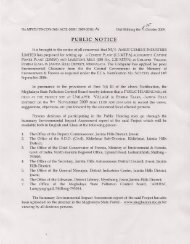
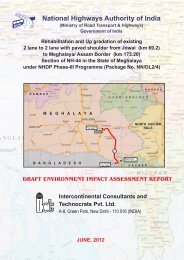

![[FORM I] - Meghalaya State Pollution Control Board](https://img.yumpu.com/49771786/1/190x245/form-i-meghalaya-state-pollution-control-board.jpg?quality=85)

